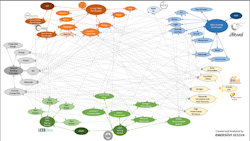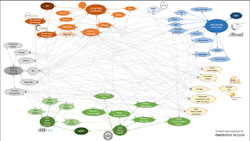Navigating the Complexity of Station Rating Systems
In today’s high-performance and sustainable building practices, we are starting to see an avalanche of rating systems and standards developed and promoted.
Whether it is LEED, WELL, Fitwel, Energy Star, Living Building Challenge, Passive House, BREEAM, or any of the various Net Zero standards, this article is here to be your guide to answering the if, what, and how these standard(s) are best for you and your fire department.
Overall, sustainability rating systems are helpful tools for owners, designers, and builders to design buildings that exceed minimal construction standards. We often say that if you’re building to minimal construction standards, you’re literally building the worst possible building that is legally allowed.
As we begin to analyze the popular rating systems that are out there, you can see there is an abundance of overlap:
Due to the plethora of standards, we can start to group them into various categories based on their main focus:
Comparing ratings systems
After grouping the standards into categories we can easily start to compare the systems. For example, LEED, Guiding Principles, and BREEAM can be grouped together into a category focused on building efficiencies. WELL, Fitwel, and RESET can be grouped together into a health category. Alternatively, even though many of these standards can be grouped into categories, this does not mean that they only cover one key performance strategy. For example, BREEAM is a holistic building standard which branches into operational strategies, management protocols, and occupant health metrics. Or RESET, while it is grouped with WELL and Fitwel, does not compete with these two standards because RESET is focused on air quality monitoring.
Going even further, when studying the specific requirements within each standard, similarities are identified across multiple standards. For example, LEED v4.1, RESET, Fitwel, and LBC all require particulate matter 2.5 (an air quality contaminant) to be below 12 µg/m3. Or consider bicycle facilities: LEED requires covered bicycle storage within 300 feet of an entrance for 5% of building occupants as well as one on-site shower with changing facility. WELL requires the same amount of storage, but within 100 feet of an entrance. LBC requires covered storage of 15% for “human-powered vehicles,” which can include bicycles with an electric option. And finally, Fitwel has the same requirements as WELL with covered bicycle parking within 100 feet of an entrance for 5% of occupants.
As you can see, it can be complicated. Next we’ll try to simplify the current options and provide some general guidance as you consider your sustainable path forward.
Rating system method
In general, if your department or community is interested in a station with a focus on energy efficiency, water conservation, and lower carbon, then you should focus your attention on LEED, or Living Building Challenge (LBC) if you are extremely ambitious. If you have a focus on occupant health, community engagement, and mental well-being, WELL or Fitwel are more appropriate. These are becoming increasingly popular as we continue to focus more and more on the health and mental well-being of our firefighters.
Additionally, if you are interested in energy efficiency, occupant health, and excellent air quality, you may want to explore a combination of Passive House (PHIUS or PHI) with RESET Air. All of these options and any combination of overarching focus can be combined to provide you with the most applicable rating system(s).
Performance based method
Another approach is for your department to go through a performance-based target and goals setting workshop to be introduced to the variety of rating systems, how they interconnect, and what aspects can be the most beneficial for your facility and/or community. The result is a step-by-step plan developed by picking and choosing the best strategies and targets from each of the various rating systems.
This integrative method allows your department to be in complete control of the goals and set clear, measurable expectations for the design and construction teams. The result is a project and project team that has a full understanding of the goals and what must be achieved to successfully complete the project. While this approach may not always lead to a specific certification, it may provide you with a better value to your community because the budget is spent on specific criteria that is important to you versus hunting for insignificant points just to achieve an ambiguous certification level.
Conclusion
Both methods (certification pursuit or performance-based pursuit) can result in great improvements beyond minimum construction standards.
The certification pathway offers your department, and your design team, the comfort of an established rating system with clear guidelines on how to achieve a desired certification. The drawback is that often the design team must “hunt for points” in order to fulfill the contractual obligation of a specific rating system. This can often lead to unnecessary spending for items that may not be relevant to your project.
The performance-based method allows your department to clearly identify measurable expectations for the project with the confidence that the budget is appropriately used. However, this method has its own set of drawbacks, including longer research times for the design team to analyze cost effective strategies to achieve the targets.
As you can see from the discussion, many of today’s standards contain the same or very similar references. For this reason, it is best for communities to hire architectural consultants or independent sustainability consultants with a strong knowledge around multiple sustainability standards and rating systems.
Upon understanding how your organization and community functions, the consultant can then provide you with a narrowed list of rating standard options or performance-based goals that best fits with your department, your culture, and your design expectations for the project. A consultant can ensure sustainability outcomes are right-sized for your community, your department and most importantly, your budget.
_____
Rating System References:
- WELL: https://www.wellcertified.com/
- Fitwel: https://www.fitwel.org/
- LEED: https://www.usgbc.org/leed
- Living Building: https://living-future.org/lbc/
- RESET Air: https://www.reset.build/
- Passive House PHIUS: https://www.phius.org/home-page
- Passive House PHI: https://passivehouse.com/
- Energy Star: https://www.energystar.gov/buildings?s=mega
- BREEAM: https://www.breeam.com/
About the Author
Tim Wiley
Tim Wiley, Principal and Fire Station Design Expert, is an architect and Civic Group Leader at emersion DESIGN. He is a regular speaker at national design conferences, presenting on sustainable, healthy buildings, and resilient public safety design. Tim is recognized for his public safety design expertise and thoughtful, operations-based, lasting design principles.
Chad Edwards
Chad Edwards, Principal and Sustainability Expert for emersion DESIGN LLC, has completed nine (9) Net-Zero Energy projects, including some of the most sustainable projects in the Midwest, such as the World's first LEED Platinum and Net-Zero Energy Police Station.
Yasha Ogg
Yasha Ogg, Healthy Building Expert at emersion DESIGN LLC, is a designer, speaker and advocate for healthy, sustainable building design. He is also a WELL faculty member and leads the movement to improve health and well-being in buildings and communities across the world.


